On April 12th, legal data analytics firm Lex Machina released a litigation update report for the first quarter of 2017 which highlights trends in intellectual property suits being filed in U.S. district courts. One of the key findings is that only 938 patent infringement actions were filed in district courts during the recent quarter, a total which is the lowest for a single quarter since the third quarter of 2011 when only 921 such cases were filed.
Although that data point sounds significant, Lex Machina data scientist Brian Howard notes that this results fits well within a pattern in patent litigation which has played out in recent years. “Generally, when people see the words ‘new low in litigation level,’ they assume that litigation fell off of a cliff,” Howard said. “That’s not the case here.” The most recent quarter almost saw as many cases filed as the first quarter of 2016, when 963 patent infringement cases were filed in U.S. district courts. Howard also noted that, in recent years, the first quarter of the calendar year typically sees a drop in the number of cases filed from the total number filed in the fourth quarter of the previous year.
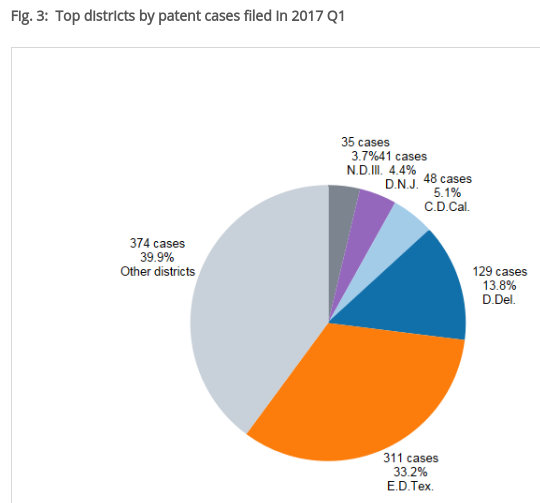 The U.S. District Court for the Eastern District of Texas (E.D. Tex.) remains the most active court for patent infringement suits, receiving one-third of all patent infringement cases filed in 2017’s first quarter. However, that high percentage of case filings concentrated in E.D. Tex. is down from 40 percent in last year’s fourth quarter, correlating with a similar drop in total litigation numbers. According to Howard, this dip in E.D. Tex.’s percentage of overall case filings is due in large part to a continuing decline in the number of cases filed by what the Lex Machina report identifies as high-volume plaintiffs, a subset of parties filing at least 10 patent infringement actions within 365 days. While high-volume plaintiffs are responsible for a small portion of the total number of patent infringement actions filed in the U.S., they are responsible for most of the litigation filed in E.D. Tex. High-volume plaintiffs also contribute a great deal to the caseload found in the U.S. District Court for the District of Delaware (D. Del.), the district court which routinely sees the second-highest caseload of patent infringement actions. D. Del. received 14 percent of all patent infringement suits filed in 2017’s first quarter.
The U.S. District Court for the Eastern District of Texas (E.D. Tex.) remains the most active court for patent infringement suits, receiving one-third of all patent infringement cases filed in 2017’s first quarter. However, that high percentage of case filings concentrated in E.D. Tex. is down from 40 percent in last year’s fourth quarter, correlating with a similar drop in total litigation numbers. According to Howard, this dip in E.D. Tex.’s percentage of overall case filings is due in large part to a continuing decline in the number of cases filed by what the Lex Machina report identifies as high-volume plaintiffs, a subset of parties filing at least 10 patent infringement actions within 365 days. While high-volume plaintiffs are responsible for a small portion of the total number of patent infringement actions filed in the U.S., they are responsible for most of the litigation filed in E.D. Tex. High-volume plaintiffs also contribute a great deal to the caseload found in the U.S. District Court for the District of Delaware (D. Del.), the district court which routinely sees the second-highest caseload of patent infringement actions. D. Del. received 14 percent of all patent infringement suits filed in 2017’s first quarter.
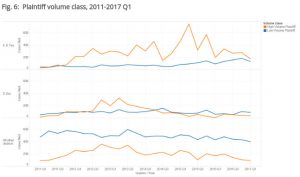 Past litigation reports from Lex Machina have pointed to the fact that volatility in patent case filings are typically triggered by changes to the patent system, or even just proposed changes. Spikes in patent litigation have closely preceded changes like the abrogation of Form 18 to plead patent infringement in district court as well as the enactment of provisions of the America Invents Act. Given the fact that the debate on patent reform isn’t currently reverberating in Congress the way it has in recent years, it’s possible that the recent downturn in high-volume plaintiff filings is due to calmer waters in the patent system. The next foreseeable change to the U.S. patent system stem from the U.S. Supreme Court’s upcoming decision in TC Heartland v. Kraft Foods Group Brands, so it will be interesting to see if the court’s ruling in that case creates any similar volatility in case filings.
Past litigation reports from Lex Machina have pointed to the fact that volatility in patent case filings are typically triggered by changes to the patent system, or even just proposed changes. Spikes in patent litigation have closely preceded changes like the abrogation of Form 18 to plead patent infringement in district court as well as the enactment of provisions of the America Invents Act. Given the fact that the debate on patent reform isn’t currently reverberating in Congress the way it has in recent years, it’s possible that the recent downturn in high-volume plaintiff filings is due to calmer waters in the patent system. The next foreseeable change to the U.S. patent system stem from the U.S. Supreme Court’s upcoming decision in TC Heartland v. Kraft Foods Group Brands, so it will be interesting to see if the court’s ruling in that case creates any similar volatility in case filings.
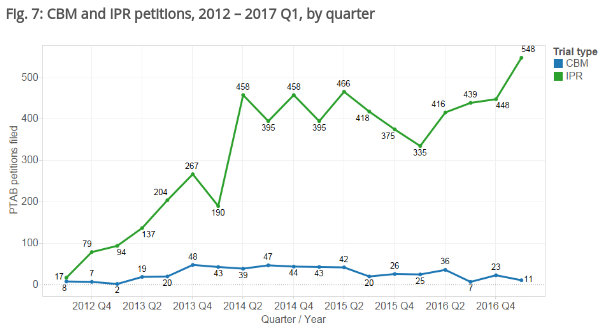 Over at the Patent Trial and Appeal Board (PTAB), the first quarter of 2017 saw a breakout in the number of petitions filed for inter partes review (IPR) proceedings, up to a total of 548 such petitions filed through the first three months of the year. Between the second quarter of 2014 and the fourth quarter of last year, IPR filings had generally remained within a range from 375 petitions up to about 460 petitions, with the first quarter of 2016 resulting in a low of 335 IPR petitions. As Howard notes, the recent quarter represents a significant bump in PTAB activity. The two companies who have had the most IPRs filed against them in the recent quarter are Japanese corporation Goda Kaisha IP Bridge 1 and Santa Clara, CA-based digital entertainment advertising platform developer Rovi Guides, Inc.
Over at the Patent Trial and Appeal Board (PTAB), the first quarter of 2017 saw a breakout in the number of petitions filed for inter partes review (IPR) proceedings, up to a total of 548 such petitions filed through the first three months of the year. Between the second quarter of 2014 and the fourth quarter of last year, IPR filings had generally remained within a range from 375 petitions up to about 460 petitions, with the first quarter of 2016 resulting in a low of 335 IPR petitions. As Howard notes, the recent quarter represents a significant bump in PTAB activity. The two companies who have had the most IPRs filed against them in the recent quarter are Japanese corporation Goda Kaisha IP Bridge 1 and Santa Clara, CA-based digital entertainment advertising platform developer Rovi Guides, Inc.
As is typically the case in recent years, trademark litigation levels continued on a very slow decline in the most recent quarter. A total of 732 trademark cases were filed in 2017’s first quarter, a drop from the 859 cases filed in last year’s fourth quarter. The only significant spike in recent years came in the third quarter of 2014 when a total of 1,431 trademark infringement cases were filed, 461 of which were related to a string of cases filed by former National Football League players against the league for the usage of their likenesses.
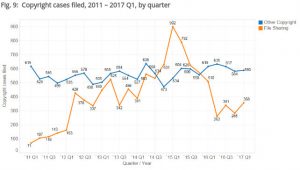 In copyright litigation, there appears to be a slight re-emergence of a trend towards increased file sharing cases, which are copyright actions filed against John Doe defendants, Internet protocol addresses and Internet service providers involving the sharing of video files through file sharing platforms like BitTorrent. Although file sharing cases were down from the most recent high of 902 cases filed in the first quarter of 2015, the 358 cases filed in 2017’s first quarter was up from the 285 cases filed in the fourth quarter of last year.
In copyright litigation, there appears to be a slight re-emergence of a trend towards increased file sharing cases, which are copyright actions filed against John Doe defendants, Internet protocol addresses and Internet service providers involving the sharing of video files through file sharing platforms like BitTorrent. Although file sharing cases were down from the most recent high of 902 cases filed in the first quarter of 2015, the 358 cases filed in 2017’s first quarter was up from the 285 cases filed in the fourth quarter of last year.
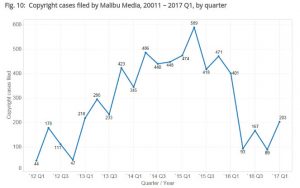 Much of this copyright litigation is driven by Malibu Media LLC, a plaintiff listed in 203 file sharing cases filed during the first quarter. As Howard noted, that makes Malibu Media responsible for more than one quarter of the total 948 copyright cases filed in U.S. district court during the first quarter. In 2016’s fourth quarter, Malibu Media only filed 89 file sharing suits, contributing about 10 percent of a total of 869 copyright infringement actions filed during that quarter. Past Lex Machina copyright litigation reports have indicated that Malibu Media has a settlement rate of about 90 percent on its file sharing cases with a majority of its damages being awarded on default judgments. “Malibu Media’s behavior resembles the behavior of somebody looking for a nuisance value suit,” Howard said.
Much of this copyright litigation is driven by Malibu Media LLC, a plaintiff listed in 203 file sharing cases filed during the first quarter. As Howard noted, that makes Malibu Media responsible for more than one quarter of the total 948 copyright cases filed in U.S. district court during the first quarter. In 2016’s fourth quarter, Malibu Media only filed 89 file sharing suits, contributing about 10 percent of a total of 869 copyright infringement actions filed during that quarter. Past Lex Machina copyright litigation reports have indicated that Malibu Media has a settlement rate of about 90 percent on its file sharing cases with a majority of its damages being awarded on default judgments. “Malibu Media’s behavior resembles the behavior of somebody looking for a nuisance value suit,” Howard said.

![[IPWatchdog Logo]](https://ipwatchdog.com/wp-content/themes/IPWatchdog%20-%202023/assets/images/temp/logo-small@2x.png)

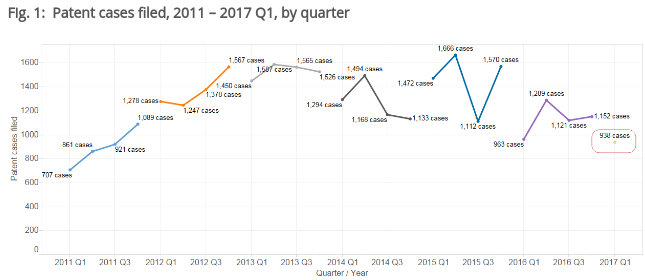
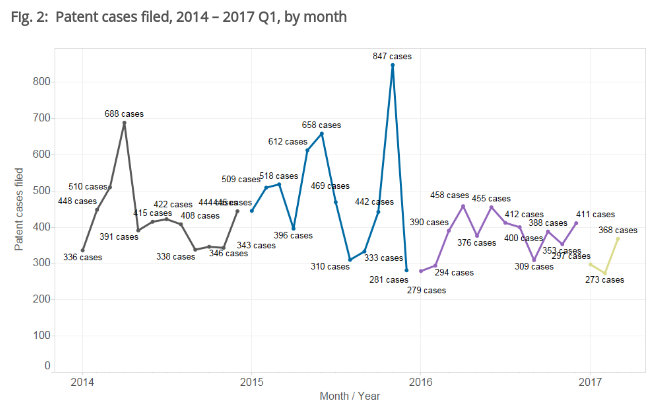
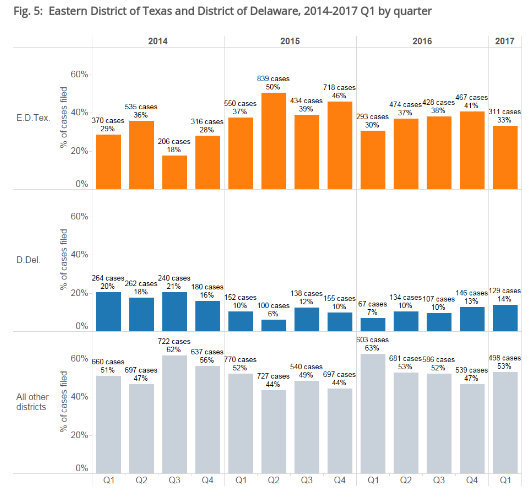
![[Advertisement]](https://ipwatchdog.com/wp-content/uploads/2024/04/Patent-Litigation-Masters-2024-sidebar-early-bird-ends-Apr-21-last-chance-700x500-1.jpg)

![[Advertisement]](https://ipwatchdog.com/wp-content/uploads/2021/12/WEBINAR-336-x-280-px.png)
![[Advertisement]](https://ipwatchdog.com/wp-content/uploads/2021/12/2021-Patent-Practice-on-Demand-recorded-Feb-2021-336-x-280.jpg)
![[Advertisement]](https://ipwatchdog.com/wp-content/uploads/2021/12/Ad-4-The-Invent-Patent-System™.png)







Join the Discussion
4 comments so far.
Night Writer
May 1, 2017 01:04 pmNo one should trust anything coming from this Lemley owned company. Lemley is unethical and from what I’ve seen the “statistics” they provide cannot be trusted. Just more Lemley unethical nonsense.
Anon
April 30, 2017 06:31 pmAngry dude – thank you for adding the AIA joinder provision reminder.
angry dude
April 30, 2017 05:11 pmConsidering the joinder provision of AIA, even if total numbers were the same or slightly up, in reality they would be drastically down…
But… according to some, we do have a robust patent market in US
Anon
April 30, 2017 10:08 amIn various comments here and at other patent blogs, the importance of normalizing data has been discussed – especially when data is being used for political and/or philosophical purposes.
The data underpinning this article would not be an exception from that viewpoint.
In truth, normalizing the data would even more dramatically highlight some of the more pervasive propaganda that exists regarding the patent system (and the “terribleness” of trying to enforce one’s property rights through the court system).
To wit: taking a pure count view misses the fact that the population from which those counts originate have NOT been a steady state number, but rather – and as should be expected since innovation begets innovation – has been an increasing number, even given the attempts to denigrate what once was the best system in the entire world.
If we were to treat statistics on automobile deaths as a “pure count” view, automobiles would have been banned long ago because auto deaths are many (many, many) multiples higher than the preceding mode of transportation related deaths.
This is exactly the point wherein the whining of the anti-patent folk needs to be put front and center.
Specifically, I am thinking of the whining that so often accompanies any presentation of the other “pure number” aspect of patents being granted.
It is THAT number that serves as the proper norming factor to take into account when we want to look at the “pure number” of the focus of this article.
Actually, the number to use is a multiplier of the active number of patents out there, as it is (or should be) known that a lawsuit may arise from each individual patent claim, and not just from the straight number of actual patents in force.
Of course, this rather sizable number – when applied in a proper norming statistical treatment will be in the denominator of what anti-patent folks want to use as an indicator of “badness.”
In plain words, the “badness” is far lower and trending deeply lower than what those with an anti-patent agenda want to acknowledge.
And that’s not even looking at the positive aspects of being able to duly enforce one’s property rights as provided for in our system of law and order.
But doing so (acknowledging the true normalized state) will eviscerate their favorite propaganda tool, so rest assured that the proper treatment will never be acknowledged.
Instead, we will continue to have those (Citizen’s United-enabled) voice$ spreading the FUD that we need to weaken patents and patent enforcement even more…